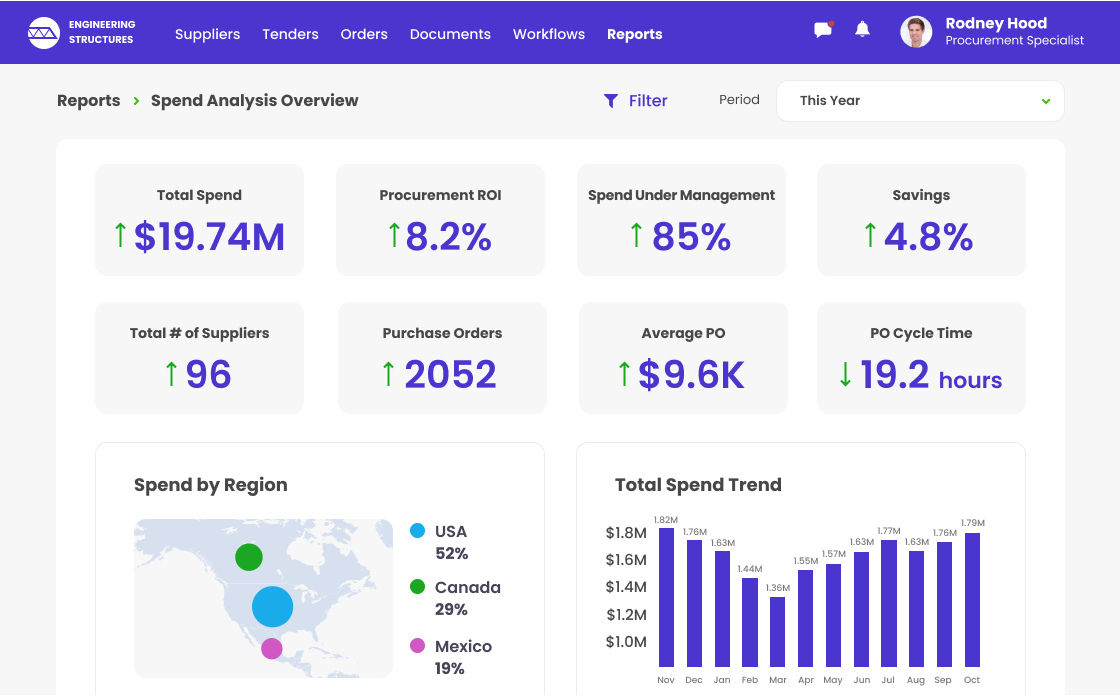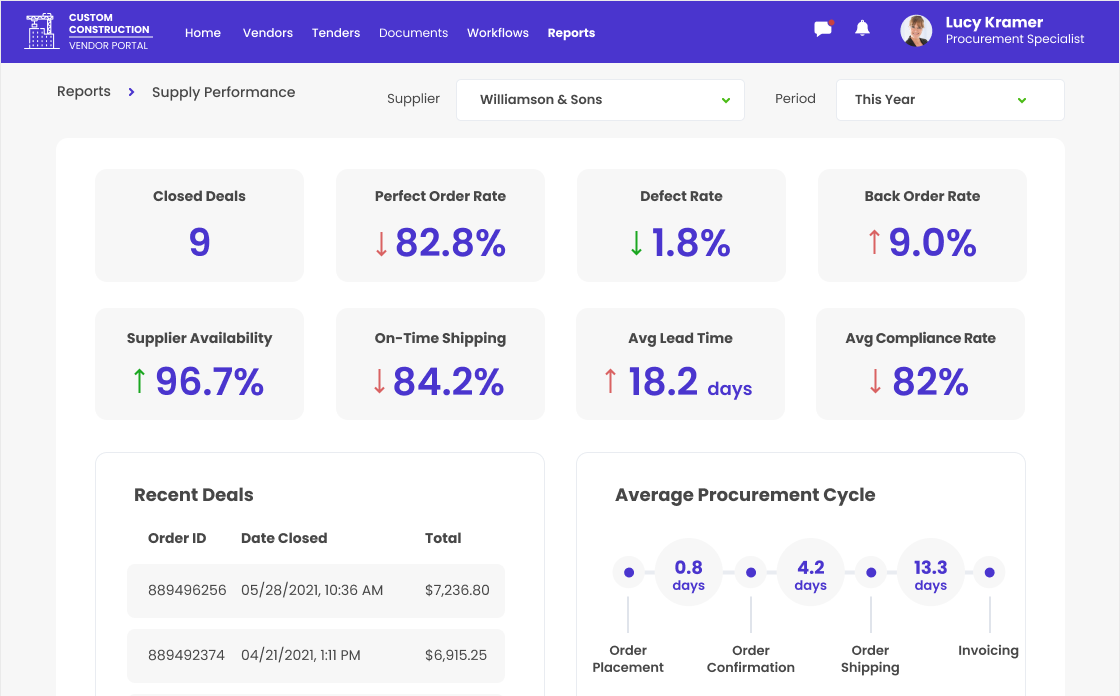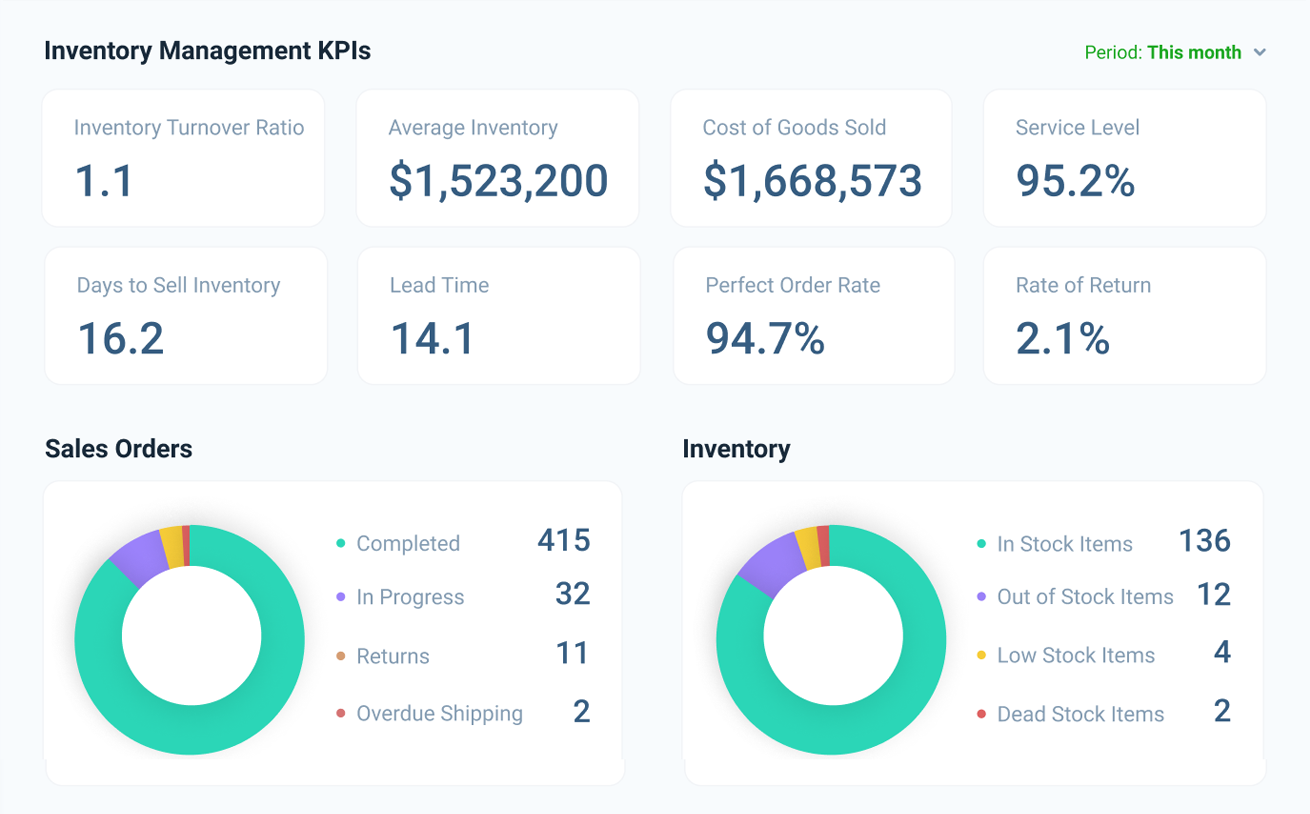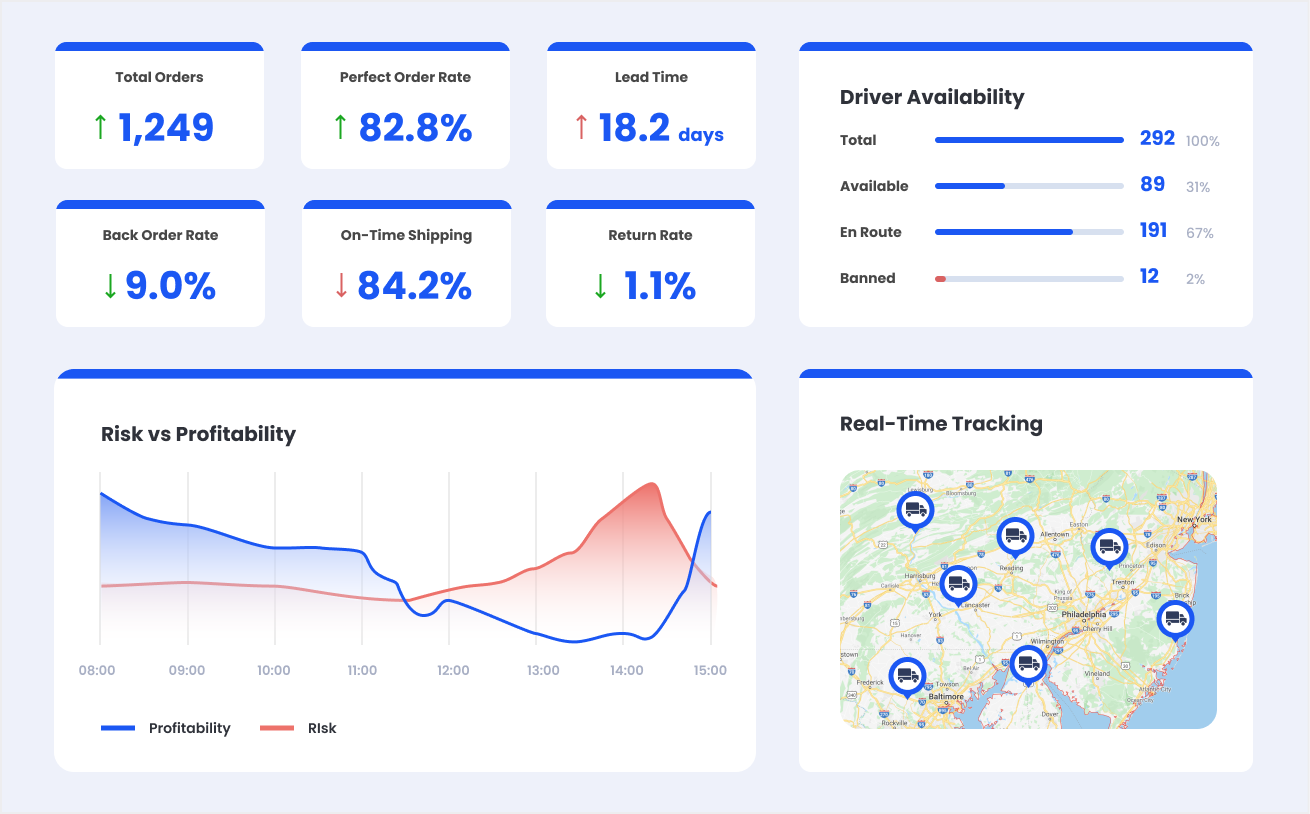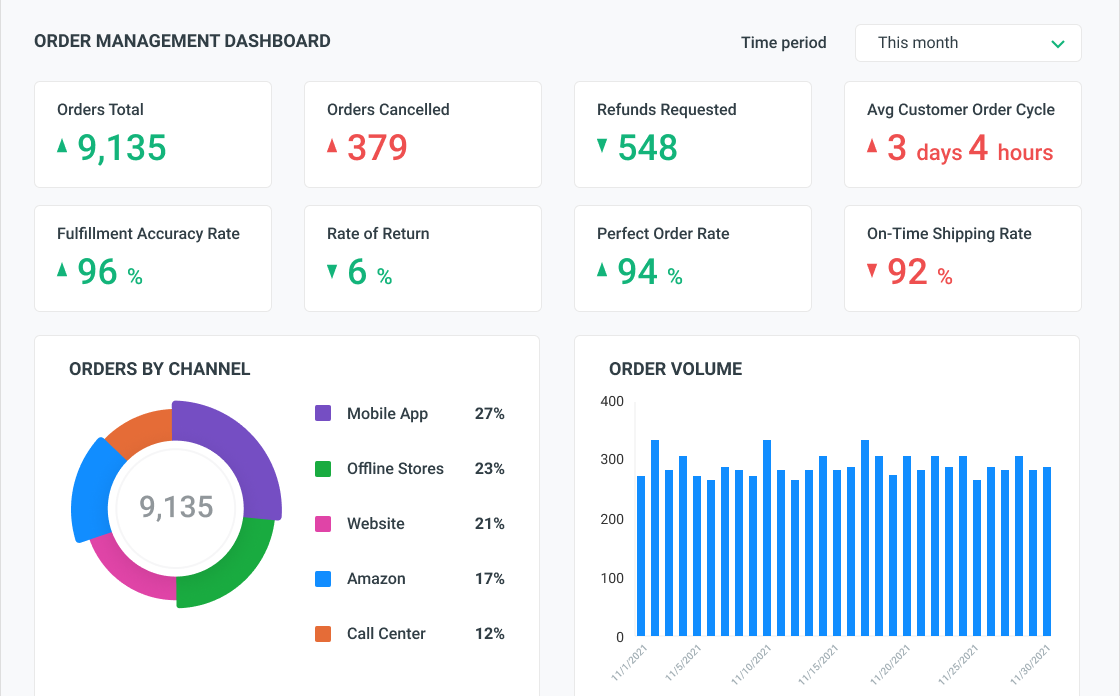Supply Chain Analytics
Data-Driven Supply Chain Planning, Optimization, and Risk Management
In data analytics since 1989 and in supply chain IT since 2012, ScienceSoft helps companies design, develop, integrate, and upgrade supply chain analytics solutions.
Supply Chain Data Analytics Solution in Brief
Supply chain data analytics helps plan and optimize supply chain operations based on analytical insights. Supply chain analytics allows businesses to achieve real-time visibility into the entire SCM process, cost savings through informed inventory management, and operational efficiency through transportation route optimization and risk mitigation related to supplier disruptions and demand fluctuations. Building supply chain analytics solutions, ScienceSoft is committed to achieving project goals regardless of time and budget constraints and changing requirements. To achieve this, we follow project management practices that we’ve continuously polished since 1989.
- Integrations: ERP, CRM, a procurement management system, an order management system, supplier management system, inventory management system.
- Implementation costs: $70,000–$1,000,000, depending on the number of integrations, data volume and complexity, the need for ML/AI-powered capabilities, and other factors. Use our online calculator to estimate the cost for your case.
The Architecture of a Supply Chain Analytics Solution
Supply chain analytics solution usually comprises the following elements:

- Data source layer: Real-time and historical data from internal data sources (a supply chain management system, ERP, CRM, accounting software, smart connected things, etc.) and real-time external data (social media feeds, weather forecasts, social data about strikes, fires, or bankruptcies, etc.).
- Data integration layer: To extract, transform and load historical and real-time supply chain data in the format suitable for storing in a data lake, an operational data store and a data warehouse.
- Data storage layer: To store data in its raw or preprocessed format in the data lake or an operational data store and structure and store data for analytical querying and reporting in the data warehouse.
- Data analytics layer: To run simple analytical queries on operational data, multidimensional analytical queries with OLAP tools on structured historical data, build machine learning and data mining models to facilitate predictive and prescriptive data analysis.
Core Functionality for a Supply Chain Analytics Solution
With 36 years in data analytics, and 13 years - in supply chain management, ScienceSoft designs and builds supply chain analytics solutions with customers' business needs at the core. Below, our experts share the core functionality of a supply chain analytics solution:
Key Integrations for Supply Chain Analytics Software
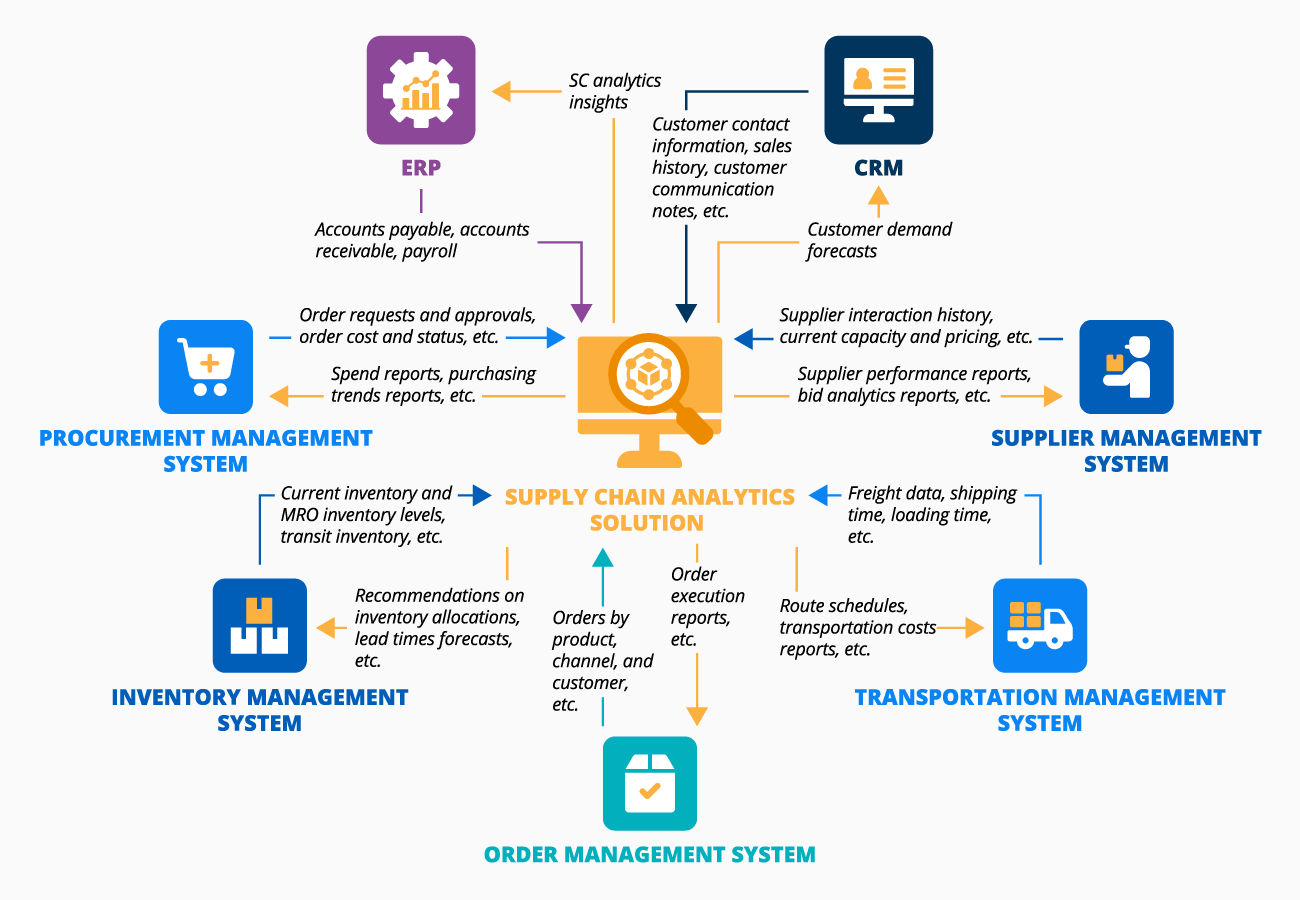
At ScienceSoft, we don't see a supply chain analytics solution as a stand-alone system. To enable it provide valuable insights, ScienceSoft integrates supply chain analytics with the following systems:
- Procurement management system – for spend monitoring and analysis, purchasing trends analysis, spend forecasting, etc.
- Supplier management system – for supplier performance monitoring and analysis, supplier risk analysis, bid analysis, payment terms analysis, AI-based recommendations on supplier assignment to purchase orders, etc.
- Inventory management system – for data-driven inventory allocation across different storage locations, inventory demand planning, lead times prediction, etc.
- Transportation management system – for the overall freight spend analysis, route schedules planning, transportation costs analysis, carrier analysis, shipping method analysis, etc.
- Order management system – for order execution analysis, returned order analysis, delayed order analysis, etc.
- Enterprise resource planning (ERP) system – for analyzing procurement, storage, transportation, etc. costs, identifying how the disruptions in the supply chain influence the bottom line, devise strategies for reducing the end-to-end supply chain costs; for leveraging supply chain analytics insights at all levels of enterprise planning (operational and business planning).
- Customer relationship management (CRM) system – for comprehensive customer demand forecasting and planning.
Cost of Supply Chain Analytics Implementation
The cost of supply chain analytics implementation may range from $70,000 to $1,000,000+. The major cost drivers include the following:
- The number of data sources for integration (ERP, CRM, order management system, supplier management system, logistics management system, etc.).
- Data complexity (structured, semi-structured, unstructured, real-time, etc.).
- Data volume.
- Complexity of supply chain data cleansing.
- Complexity of data analysis, ML and AI capabilities.
- Data security requirements.
- User training, if necessary.
$70,000–$200,000
A basic solution that:
- Integrates with up to 2 data sources, e.g., ERP, CRM.
- Supports structured data, e.g., data on stock levels, sales data.
- Enables batch data processing (e.g., every 2 hours, every 24 hours, every week).
- Enables rule-based analytics, e.g., automated order placement based on reorder point rule, segmenting products into performance categories based on their profitability.
$200,000–$400,000
A solution of medium complexity that:
- Integrates with up to 7 data sources.
- Supports structured and unstructured data (e.g., images from an inventory counting system powered by computer vision).
- Enables batch and real-time data processing.
- Enables rule-based and ML/AI-powered analytics, e.g., inventory demand forecasting based on historical and real-time data.
$400,000–$1,000,000
An advanced solution that:
- Integrates with multiple internal and external systems.
- Supports real-time big data analytics (e.g., constantly arriving readings from truck sensors).
- Enables batch and real-time data processing.
- Enables advanced AI-powered analytics (e.g., dynamic route optimization based on real-time traffic and weather data).
Get a ballpark estimate for your case with our free calculator
Answer a few simple questions about your analytics needs, and we’ll get back shortly with a tailored quote.
Factors Determining Supply Chain Analytics Success
ScienceSoft's consultants have defined important factors that should be covered to ensure the success of supply chain analytics solutions:
Robust data security
Comprehensive security features such as data anonymization, end-to-end data encryption, fine-grained access control, data masking, etc., ensure the safety of data under analysis and compliance with specific regulations (e.g., GDPR).
Self-service user interface
End users with no tech expertise can use drag-and-drop functionality to create interactive dashboards, drill-down and NLP features to derive actionable insights and share them with colleagues, get AI-based recommendations on next-best actions, etc., which drives supply chain analytics adoption.
Solution scalability
The architectural flexibility of a supply chain analytics solution ensures the ability to seamlessly integrate with new data sources, scale the storage capacity, leverage advanced analytics capabilities, etc.
What You Get with Supply Chain Analytics
The major financial outcomes include:
|
|
Minimized supply chain risks and optimized product flow Early identification of supply chain disruptions and prediction of the future risks (e.g., extreme price swings due to interruptions in the flow of raw goods) for quick risk assessment and mitigation. |
|
|
Enhanced supply chain planning End-to-end visibility into and analysis of each component of the supply chain to achieve consistency in procurement planning, production planning, sales planning, etc. and fulfill the demand cost-efficiently. |
|
|
Maximized ability to meet demand and up to 20-30% fewer inventory costs Accurate demand forecasting, identification of an optimal inventory level, and optimal shipping frequency and quantity help plan capacity and minimize stockouts and overstocks. |
Software ScienceSoft Recommends for Supply Chain Analytics
Below, we list the tools that we frequently use in our supply chain analytics projects.
Microsoft Power BI
Best for
Self-service company-wide supply chain intelligence.
Description
- Facilitated ingestion of supply chain data across the company with 120+ native data source connectors, including pre-built connectors for a data lake and operational databases.
- Self-service data preparation and analytics capabilities for Power BI users to create tailored supply chain data reports and dashboards in minutes.
Pricing
Free Plan.
Power BI Pro – $9.99/user/month.
Power BI Premium:
- $4,995/dedicated cloud storage and compute resources/month
- $24/user/month
Azure Synapse Analytics
Best for
Storing supply chain data for complex analytical querying.
Description
- Integrating supply chain data from hundreds of data sources across the company’s divisions, subsidiaries, etc. to perform analytical querying in seconds.
- Reporting on all management levels, from C-suite to directors, managers and supervisors, is protected with a fine-grained data access control.
Pricing
Compute:
- On-demand pricing: $1.20/hour (DW100c) – $360/hour (DW30000c).
- Reserved instance pricing can save up to 65% over the on-demand option (in a 3-year term).
Data storage: $122.88/TB/month.
Note: No charge for the amount of data processed.

Amazon Redshift
Best for
Warehousing for supply chain big data.
Description
- SQL-querying of exabytes of structured, semi-structured, and unstructured supply chain data across the data warehouse, operational data stores, and a data lake.
- The supply chain data can further be analyzed with big data analytics and ML services.
Pricing
On-demand pricing – $0.25 - $13.04/hour.
Reserved instance pricing offers saving up to 75% over the on-demand option (a 3-year term).
Data storage (RA3 node type): $0.024/GB/month.
Note: No charge for the amount of data processed.
Consider Professional Services for Supply Chain Analytics Implementation
Having established project management practices, ScienceSoft drives the success of analytics projects regardless of time and budget constraints, as well as changing business requirements. We help businesses design, implement and modernize supply chain analytics solutions to consolidate supply chain data under one roof, achieve visibility into supply chain operations, and support the decision-making for supply chain planning and optimization.
Supply chain analytics software consulting
- Analysis of supply chain analytics needs and the existing supply chain software infrastructure.
- Supply chain analytics solution conceptualization and design.
- Supply chain analytics solution implementation planning (milestones, risk management planning, defining KPIs for measuring supply chain analytics software quality, etc.).
- Business case creation, including cost estimation, time budget estimates.
Supply chain analytics software implementation
- Analysis of supply chain analytics needs and drawing up requirements for supply chain analytics software.
- Supply chain analytics solution conceptualization and tech selection.
- Supply chain analytics solution development.
- Supply chain analytics software quality assurance.
- After-launch support and optimization.

About ScienceSoft
ScienceSoft is an IT consulting and software development company headquartered in McKinney, Texas. We help our clients implement tailored data analytics solutions for the supply chain to turn voluminous supply chain data into insights for informed supply chain risk management, planning and optimization. ISO 9001 and ISO 27001 certified, we rely on a mature quality management system and guarantee cooperation with us does not pose any risks to our clients’ data security. Contact us to know more about supply chain analytics software implementation.
